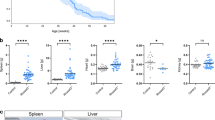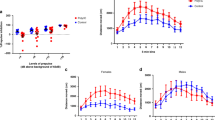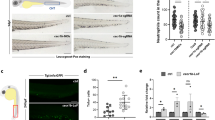Abstract
Aicardi-Goutières syndrome (AGS) presents as a severe neurological brain disease and is a genetic mimic of the sequelae of transplacentally acquired viral infection1,2. Evidence exists for a perturbation of innate immunity as a primary pathogenic event in the disease phenotype3. Here, we show that TREX1, encoding the major mammalian 3′ → 5′ DNA exonuclease4, is the AGS1 gene, and AGS-causing mutations result in abrogation of TREX1 enzyme activity. Similar loss of function in the Trex1−/− mouse leads to an inflammatory phenotype5. Our findings suggest an unanticipated role for TREX1 in processing or clearing anomalous DNA structures, failure of which results in the triggering of an abnormal innate immune response.
This is a preview of subscription content, access via your institution
Access options
Subscribe to this journal
Receive 12 print issues and online access
$209.00 per year
only $17.42 per issue
Buy this article
- Purchase on SpringerLink
- Instant access to full article PDF
Prices may be subject to local taxes which are calculated during checkout


Similar content being viewed by others
References
Aicardi, J. & Goutières, F. A progressive familial encephalopathy in infancy with calcifications of the basal ganglia and chronic cerebrospinal fluid lymphocytosis. Ann. Neurol. 15, 49–54 (1984).
Sanchis, A. et al. Genetic syndrome mimics congenital infection. J. Pediatr. 146, 701–705 (2005).
Crow, Y.J. et al. Cree encephalitis is allelic with Aicardi-Goutières syndrome; implications for the pathogenesis of disorders of interferon alpha metabolism. J. Med. Genet. 40, 183–187 (2003).
Lindahl, T., Gally, J.A. & Edelman, G.M. Properties of deoxyribonuclease 3 from mammalian tissues. J. Biol. Chem. 244, 5014–5019 (1969).
Morita, M. et al. Gene-targeted mice lacking the Trex1 (DNase III) 3′ → 5′ DNA exonuclease develop inflammatory myocarditis. Mol. Cell. Biol. 24, 6719–6727 (2004).
Goutières, F. et al. Aicardi-Goutières syndrome: an update and results of interferon-α studies. Ann. Neurol. 44, 900–907 (1998).
Lebon, P. et al. Intrathecal synthesis of interferon-alpha in infants with progressive familial encephalopathy. J. Neurol. Sci. 84, 201–208 (1988).
Dale, R.C., Tang, S.P., Heckmatt, J.Z. & Tatnall, F.M. Familial systemic lupus erythematosus and congenital infection-like syndrome. Neuropediatrics 31, 155–158 (2000).
Aicardi, J. & Goutières, F. Systemic lupus erythematosus or Aicardi-Goutières syndrome? Neuropediatrics 31, 113 (2000).
De Laet, C. et al. Phenotypic overlap between infantile systemic lupus erythematosus and Aicardi-Goutieres syndrome. Neuropediatrics 36, 399–402 (2005).
Lebon, P. et al. Synthesis of intrathecal interferon in systemic lupus erythematosus with neurological complications. Br. Med. J. 287, 1165–1167 (1983).
Preble, O.T., Black, R.J., Friedman, R.M., Klippel, J.H. & Vilcek, J. Systemic lupus erythematosus: presence in human serum of an unusual acid-labile leukocyte interferon. Science 216, 429–431 (1982).
Batteux, F., Palmer, P., Daeron, M., Weill, B. & Lebon, P.F.C. γRII (CD32)-dependent induction of interferon-alpha by serum from patients with lupus erythematosus. Eur. Cytokine Netw. 10, 509–513 (1999).
Raymond, A.A., Zariah, A.A., Samad, S.A., Chin, C.N. & Kong, N.C. Brain calcification in patients with cerebral lupus. Lupus 5, 123–128 (1996).
Rich, S.A., Owens, T.R., Anzola, M.C. & Bartholomew, L.E. Induction of lupus inclusions by sera from patients with systemic lupus erythematosus. Arthritis Rheum. 29, 501–507 (1986).
Stephenson, J.B. Aicardi-Goutieres syndrome–observations of the Glasgow school. Eur. J. Paediatr. Neurol. 6 (Suppl.), 67–70 (2002).
Crow, Y.J. et al. Aicardi-Goutières syndrome displays genetic heterogeneity with one locus (AGS1) on chromosome 3p21. Am. J. Hum. Genet. 67, 213–221 (2000).
Black, D.N. et al. Encephalitis among Cree children in northern Quebec. Ann. Neurol. 24, 483–489 (1988).
Ali, M. et al. A second locus for Aicardi-Goutières syndrome at chromosome 13q14–21. J. Med. Genet. 43, 444–450 (2005).
Crow, Y.J. et al. Mutations in genes encoding ribonuclease H2 subunits cause Aicardi- Goutières syndrome, which mimics congenital viral brain infection. Nat. Genet. advance online publication 16 July 2006 (doi:10.1038/ng1842).
Napirei, M. et al. Features of systemic lupus erythematosus in DNase1-deficient mice. Nat. Genet. 25, 177–181 (2000).
Kawane, K. et al. Impaired thymic development in mouse embryos deficient in apoptotic DNA degradation. Nat. Immunol. 4, 138–144 (2003).
Yasutomo, K. et al. Mutation of DNASE1 in people with systemic lupus erythematosus. Nat. Genet. 28, 313–314 (2001).
Mazur, D.J. & Perrino, F.W. Structure and expression of the TREX1 and TREX2 3′ → 5′ exonuclease genes. J. Biol. Chem. 274, 14718–14727 (2001).
Hoss, M. et al. A human DNA editing enzyme homologous to the Escherichia coli DnaQ/MutD protein. EMBO J. 18, 3868–3875 (1999).
Perrino, F.W., Harvey, S., McMillin, S. & Hollis, T. The human TREX2 3′ → 5′-exonuclease structure suggests a mechanism for efficient nonprocessive DNA catalysis. J. Biol. Chem. 280, 15212–15218 (2005).
Prokunina, L. & Alarcon-Riquelme, M. The genetic basis of systemic lupus erythematosus – knowledge of today and thoughts for tomorrow. Hum. Mol. Genet. 13, R143–R148 (2004).
Dussaix, E., Lebon, P., Ponsot, G., Huault, G. & Tardieu, M. Intrathecal synthesis of different alpha-interferons in patients with various neurological diseases. Acta Neurol. Scand. 71, 504–509 (1985).
Akwa, Y. et al. Transgenic expression of IFN-alpha in the central nervous system of mice protects against lethal neurotropic viral infection but induces inflammation and neurodegeneration. J. Immunol. 161, 5016–5026 (1998).
Ishii, K.J. & Akira, S. Innate immune recognition of nucleic acids: beyond toll-like receptors. Int. J. Cancer 117, 517–523 (2005).
Acknowledgements
We sincerely thank the participating Aicardi-Goutières syndrome families for the use of genetic samples and clinical information. We thank A. Markham for helpful discussions and J. Stephenson for images and information about skin biopsy findings. We thank all clinicians for contributing samples not included in this manuscript. We thank the MRC Human Genetics Unit core sequencing service in Edinburgh, Cell Services at Clare Hall, London and the Genethon Cell Bank in Evry, France. Thanks to B. Smith for assistance with the figures, D. Webb for secretarial support and A. Sharpe for help with sample handling. This work was supported by the Leeds Teaching Hospitals Charitable Foundation and the West Riding Medical Research Trust. A.P.J. is an MRC Clinician Scientist and is funded by the MRC. P.R., D.E.B. and T.L. are funded by Cancer Research UK.
Author information
Authors and Affiliations
Contributions
Y.J.C. was responsible for the development of the project and wrote the paper with D.T.B., A.P.J., D.E.B. and T.L. B.E.H., R.P., M.A., A.L. and A.P.J. performed mutation screening of patients and controls. P.R. performed the TREX1 enzyme assays. All other authors provided clinical samples and data.
Note: Supplementary information is available on the Nature Genetics website.
Corresponding author
Ethics declarations
Competing interests
The authors declare no competing financial interests.
Supplementary information
Supplementary Figure 1
Primer sequences. (PDF 104 kb)
Supplementary Table 1
Chilblain-type lesions seen in individuals with AGS. (PDF 39 kb)
Rights and permissions
About this article
Cite this article
Crow, Y., Hayward, B., Parmar, R. et al. Mutations in the gene encoding the 3′-5′ DNA exonuclease TREX1 cause Aicardi-Goutières syndrome at the AGS1 locus. Nat Genet 38, 917–920 (2006). https://doi.org/10.1038/ng1845
Received:
Accepted:
Published:
Issue Date:
DOI: https://doi.org/10.1038/ng1845



